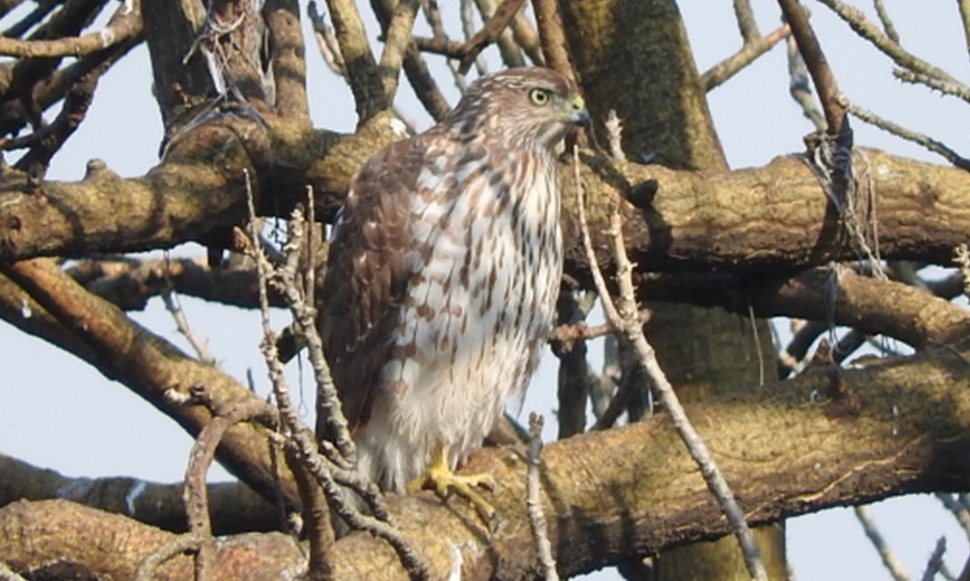Una revisión sobre la migración de las aves rapaces y los efectos toxicológicos de los metales pesados
DOI:
https://doi.org/10.31644/IMASD.31.2022.a03Palabras clave:
Rapaces, Migración, Especies bio-indicadoras, Metales pesados, Veracruz Río de RapacesResumen
Se expone la importancia de las rapaces migratorias y su uso como bio-indicadores para determinar la presencia y concentraciones de metales pesados y metaloides, se exhibe también un panorama general sobre los efectos toxicológicos. Cabe mencionar que actividades antrópicas como la minería, la petroquímica y la agricultura son una de las principales fuentes de emisión de contaminantes ambientales. Los efectos sobre la salud de las rapaces migratorias es variable y actualmente se realizan estudios para determinar los grados de afectación. Algunos metales pesados y metaloides tienen efectos negativos sobre biomoléculas importantes del metabolismo celular; a pesar de la cantidad de trabajos realizados, los resultados no son concluyentes y los cambios en las poblaciones naturales de las especies son diversos.
Descargas
Citas
Bairlein, F. (2003). The study of bird migrations – some future perspectives. Bird Study 50: 243-253.
BirdLife International. (2004a). Birds in Europe: population estimates, trends, and conservation status. United Kingdom.
BirdLife International. (2004b). State of the world’s birds 2004: indicators, for our changing world. United Kingdom.
Campbell, M.L. (2018). Metales pesados en aves rapaces residentes y migratorias en Veracruz, México. Tesis de Maestría en Ciencias en Ecología y Biotecnología. Instituto de Biotecnología y Ecología Aplicada. Universidad Veracruzana, pp. viii-126.
Carlson, J.T., Harmata, A.R., & Restani, M. (2012). Environmental contaminants in nestling Bald Eagles produced in Montana and Wyoming. Journal of Raptor Research 46: 274-282.
Cortés-Jiménez, E.V., Mugica-Álvarez, V., González-Chávez, M.C., Carrillo-González, R., Martínez-Gordillo, M., & Vaca-Mier, M. (2013). Natural revegetation of alkaline tailing heaps at Taxco, Guerrero, Mexico. International Journal of Phytoremediation 15: 127-141.
Del Hoyo, J., & Collar, N.J. (2014). Illustrated checklist of the birds of the world. Volume 1. Non-passerines. HBW and BirdLife International, Lynx. Spain, pp. 476-699.
Fisher, I.J., Pain, D.J., & Thomas, V.G. (2006). A review of lead poisoning from ammunition sources in terrestrial birds. Biological Conservation 131: 421-432.
Hanneman, M.J. (2021). Migratory ecology, stopover and winter habitats, and mercury concentrations of Red-Shouldered Hawks (Buteo lineatus) breeding in central and northeastern Winsonsin. Thesis Master of Science in Natural Resources (Wildlife). University of Wisconsin-Stevens Pint, Wisconsin. United States of America, pp. iii-7.
Hermoso de Mendoza, M., Soler, R.F., Hernández, M.D., Gallego, R.M.E., López, B.A. & Pérez, L.M. (2006). Estudio comparativo del nivel hepático de metales pesados y metaloides en aves rapaces diurnas de Galicia y Extremadura. Revista de Toxicología 23: 138-145.
Hinrichsen, D., Robey, B., & Upadhyay, U.D. (1997). Solutions for a water-short world population reports, Series M, No. 14. Baltimore, John Hopkins School of Public Health, Population Information Program.
Hunt, W.G. (2012). Implications of sublethal lead exposure in avian scavengers. Journal of Raptor Research 46: 389-393.
Hunt, W.G., Burnham, W., Parish, C.N., Burnham, K., Mutch, B., & Oaks, J.L. (2006). Bullet fragments in deer remains: implications for lead exposure in scavengers. Wildlife Society Bulletin 34: 168-171.
Iwata, H., Watanabe, M., Kim, E-Y, Gotoh, R., Yasunaga, G., Tanabe, S., Masuda, Y., & Jujita, S. (2000). Contamination by chlorinated hydrocarbons and lead in Steller’s Sea Eagle and White-tailed Sea Eagle from Hokkaido, Japan. Pages 91-106 in M. Utea and M.J. McGrady (Eds.), First Simposium on Steller’s and White-tailed Sea Eagle in East Asia. Wild Bird Society of Japan, Tokyo, Japan.
Londoño-Franco, L.F., Londoño-Muñoz, P.T., & Muñoz-García, F.G. (2016). Los riesgos de los metales pesados en la salud humana y animal. Biotecnología en el Sector Agropecuario y Agroindustrial 14: 145-153.
Martorell, J. (2009). Intoxicaciones en aves. Asociación de Veterinarios Españoles Especialistas en Pequeños Animales 29: 172-178.
Mateo, R. (2009). Lead poisoning in wild birds in Europe and the regulations adopted by differentcountries. Pages 71-98 in R.T. Watson, M. Fuller. M. Pokras, and W.G. Hunt (Eds.), Ingestion of lead from spend ammunition: implications for wildlife and humans. The Peregrine Fund, Boise, ID U.S.A.
McLean, C.M., Koller, C.E., Rodger, J.C., & MacFarlane, G.R. (2009). Mammalian hair as and accumulative bioindicator of metal bioavility in Australian terrestrial environments. Science of the Total Environment 407: 3588-3596.
Mojica, E.K., & Watts, B.D. (2011). Bald Eagle nest productivity and contaminant monitoring at naval support facility indian head, Maryland: Final Report. Center for Conservation Biology, pp. 6-27.
Nighat, S., Iqbal, S., Nadeem, M.S., Mahmood, T., & Shah, S.I. (2013). Estimation of heavy metals residues from the feathers of Falconidae, Accipitridae, and Strigidae in Punjab, Pakistan. Turkish Journal of Zoology 37: 488-500.
Pagel, J.E., Sharpe, P.B., Garcelon, D.K., Little, A.E., Taylor, S.K., Faulkner, K.R., & Gorbics, C.S. (2012). Exposure of Bald Eagles to lead on the northern Chanel Islands, California. Journal of Raptor Research 46: 168-176.
Pandey, S. (2006). Water pollution and health (review article). Kathmandu University Medical Journal 4: 128-134.
Karn, S.K., & Harada, H. (2001). Surface water pollution in three urban territories of Nepal, India, and Bangladesh. Environmental Management 28: 483-496.
Kirby, J.S., Stattersfield, A.J., Butchart, S.H.M., Evans, M.I., Grimmett, R.F.A., Jones, V.R., O’Sullivan, J., Tucker, G.M., & Newton, I. (2008). Key conservation issues for migratory land- and waterbird species on the world’s mayor flyways. Bird Conservation International 18: 49-73.
Klaassen, M., Hoye, B.J., Nolet, B.A., & Buttermer, W.A. (2012). Ecophysiology of avian migration in the face of current global hazards. Philosophical Transactions of The Royal Society B 367: 1719-1732.
Krone, O., Kenntner, N., Trinogga, A., Nadjafzadeh, M., Scholtz, F., Sulawa, J., Totschek, K., Schuck-Wersig, P., & Zeischank, R. (2009). Lead poisoning in White-tailed Sea Eagle: causes and approaches to solutions in Germany. Pages 289-301 in R.T. Watson, M. Fuller. M. Pokras, and W.G. Hunt (Eds.), Ingestion of lead from spend ammunition: implications for wildlife and humans. The Peregrine Fund, Boise, ID U.S.A.
Lehner, A.F., Rumbeiha, W., Shlosberg, A., Stuart, K., Johnson, M., Domenech, R., & Langner, H. (2013). Diagnostic analysis of veterinary dried blood spots for toxic heavy metals exposure. Journal of Analytical Toxicology 37: 406-422.
Martin, M.B., Reiter, R., Pham, T., Avellanet, Y.R., Camara, J., & Lahm, M. (2003). Estrogen-like activity of metals in MCF-7 breast cancer cells. Endocrinology 144: 2425-2436.
Meza-Figueroa, D., Maier, R.M., de la O-Villanueva, M., Gómez-Álvarez, A., Moreno-Zazueta, A., Rivera, J., Campillo, A., Grandlic, C.J., Anaya, R., & Palafox-Reyes, J. (2009). The impact of unconfined mine tailings in residential areas from a mining town in a semi-arid environment: Nacozari, Sonora, Mexico. Chemosphere 77: 140-147.
Mithöfer, A., Shulze, B., & Boland, W. (2004). Biotic and heavy metal stress response in plants: evidence for common signals. FEBS Letters 566: 1-5.
Mireles, F., Dávila, J.I., Pinedo, J.L., Reyes, E., Speakman, R.J., & Glascock, M.D. (2012). Assessing urban soil pollution in the cities of Zacatecas and Guadalupe, Mexico by instrumental neutron activation analysis. Microchemical Journal 103: 158-164.
Pattee, O.H. (1985). Eggshell thickness and reproduction in American Kestrels exposed to chronic dietary lead. Archives of Environmental Contamination and Toxicology 13: 29-34.
Peralta-Videa, J.R., López, M.L., Narayan, M., Saupe, G., & Gardea-Torresdey, J. (2009). The biochemistry of enviromental heavy metal uptake by plants: Implications for the food chain. The International Journal of Biochemistry & Cell Biology 41: 1665-1677.
Ramos-Arroyo, Y.R., & Siebe-Grabach, C.D. (2006). Estrategia para identificar jales con potencial de riesgo ambiental en un distrito minero: estudio de caso en el Distrito de Guanajuato, México. Revista Mexicana de Ciencias Geológicas 23: 54-74.
Robles-Camacho, J. & Armienta, M.A. (2000). Natural chromium contamination of groundwater at Leon Valley Mexico. Journal of Geochemical Exploration 68: 167-181.
Rodríguez-Estrella, R., & Bojórquez, T.L.A. (2004). Spatial analysis in raptor ecology and conservation. Centro de Investigaciones Biológicas del Noroeste, S.C. y Comisión Nacional para el Conocimiento y Uso de la Biodiversidad. México, pp. 1-174.
Schützendübel, A., & Polle, A. (2002). Plant responses to abiotic stress: heavy metal-induced oxidative stress and protection by mycorrhization. Journal of Experimental Botany 53: 1351-1365.
SEMARNAP. (1996). Norma Oficial Mexicana NOM-001-ECOL-1996. Establece los Límites Máximos Permisibles de Contaminantes de las Descargas de Aguas Residuales en Aguas y Bienes Nacionales. Secretaría del Medio Ambiente, Recursos Naturales y Pesca, México, pp. 2-18.
SEMARNAT. (2010). Norma Oficial Mexicana NOM-059-SEMARNAT-2010. Protección Ambiental-Especies Nativas de México de Flora y Fauna Silvestres-Categorías de Riesgo y Especificaciones para su Inclusión, Exclusión o Cambio-Lista de Especies en Riesgo. Diario Oficial de la Federación, Segunda Sección. Secretaría del Medio Ambiente y Recursos Naturales. México, pp. 25-26.
SEMARNAT/SSA. (2004). Norma Oficial Mexicana NOM-147-SEMARNAT/SSA-2004. Que establece criterios para determinar las concentraciones de remediación de los suelos contaminados por arsénico, bario, berilio, cadmio, cromo hexavalente, mercurio, níquel, plata, plomo, selenio, talio y/o vanadio. Secretaría de Medio Ambiente y Recursos Naturales – Secretaría de Salubridad y Asistencia, México, pp. 38-45.
Smeets, K., Cuypers, A., Lambrechts, A., Semane, B., Hoet P., Van Laere, A., & Vangronsveld, J. (2005). Introduction of oxidative stress and antioxidative mechanisms in Phaseolus vulgaris after Cd application. Plant Physiology and Biochemistry 43: 437-444.
Stoica, A., Katzenellenbogen, B.S., & Martin, M.B. (2000). Activation of estrogen receptor α by the heavy metal cadmium. Molecular Endocrinology 14: 545-553.
Straub, R. (2007). Site guide to the birds of Veracruz. Pronatura-CONABIO. México, pp. 13-16.
UNEP. (2013). Global mercury assessment 2013: Sources, emissions, releasesand environmental transport. United Nations Environmental Programme Chemicals Branch, Ginebra, Suiza, pp. 32.
Yañez, L., García-Nieto, E., Rojas, E., Carrizales, L., Mejía, J., Calderón, J., Razo, I., & Díaz-Barriga, F. (2003). DNA damage in blood cells from children exposed to arsenic and lead in a mining area. Environmental Research 93: 231-240.
Zarazúa, G., Ávila-Pérez, P., Tejeda, S., Valdivia-Barrientos, M., Zepeda-Gómez, C., & Macedo-Miranda, G. (2013). Evaluación de los metales pesados Cr, Mn, Fe, Cu, Zn y Pb en sombrerillo de agua (Hydrocotile ranunculoides) del curso alto del Río Lerma, México. Revista Internacional de Contaminación Ambiental 29 (Sup. 2): 17-24.

Publicado
Versiones
- 01-02-2023 (2)
- 30-09-2022 (1)
Cómo citar
Número
Sección
Licencia

Esta obra está bajo una licencia internacional Creative Commons Atribución-NoComercial-CompartirIgual 4.0.























